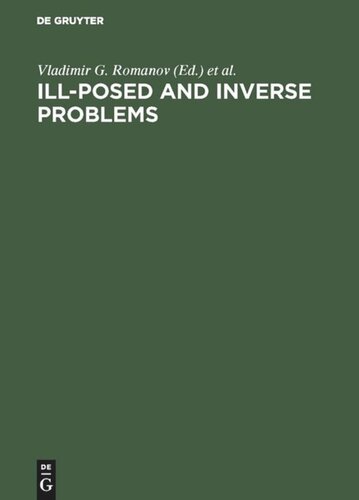

Most ebook files are in PDF format, so you can easily read them using various software such as Foxit Reader or directly on the Google Chrome browser.
Some ebook files are released by publishers in other formats such as .awz, .mobi, .epub, .fb2, etc. You may need to install specific software to read these formats on mobile/PC, such as Calibre.
Please read the tutorial at this link. https://ebooknice.com/page/post?id=faq
We offer FREE conversion to the popular formats you request; however, this may take some time. Therefore, right after payment, please email us, and we will try to provide the service as quickly as possible.
For some exceptional file formats or broken links (if any), please refrain from opening any disputes. Instead, email us first, and we will try to assist within a maximum of 6 hours.
EbookNice Team

Status:
Available0.0
0 reviews
ISBN 10: 3110942011
ISBN 13: 9783110942019
Author: Vladimir G Romanov, Sergey I Kabanikhin, Yurii E Anikonov, A L Bukhgeim
In 1968 Lavrentiev was elected as a corresponding member of the Academy of Sciences, and in 1981 as an academician. In 1987 Μ. M. Lavrentiev and his colleagues V. G. Romanov, Yu. E. Anikonov, V. R. Kireitov and S. P. Shishatsky were awarded the state prize for the results in the theory of inverse and ill-posed problems. For his activity as a scientist and professor Μ. M. Lavrentiev was awarded several other state prizes as well. Since 1986 Lavrentiev has been the director of the Sobolev Institute of Mathematics of Siberian Branch of the Russian Academy of Sciences. The last 15 years were extremely difficult for the institute because of perestroika and financial problems. Due to his organization experience and activity the institute holds high position in the science and is successfully developing. All leading scientific schools keep working. Many new doctoral and candidate dissertations have been defended during the last 15 years. Μ. M. Lavrentiev is the author of many fundamental scientific results in many directions of mathematics and its applications, namely, in differential equations, inverse and ill-posed problems, tomography, numerical and applied mathematics. A. N. Tikhonov, V. K. Ivanov and Μ. M. Lavrentiev created a new scientific direction of modern mathematics — the theory of ill-posed problems of mathematical physics and analysis, which is of considerable theoretical and practical value. By ill-posed problems are meant the problems which do not satisfy one of the classical well-posedness conditions such as uniqueness, existence and stability of the solution. Ill-posed problems are usually unstable with respect to small variations of data. A wellknown example is the Cauchy problem for Laplace equation. It turns out that some a priori information about the ill-posed problem solution makes the solution stable and allows one to construct approximations with an arbitrary accuracy. This fact was remarked by Academician A. N. Tikhonov in 1943 for an inverse problem of potential. Thus ill-posed problems become theoretically and practically valuable provided some a priori information concerning their solutions is given. Taking into account this fact Μ. M. Lavrentiev introduced the concept of a conditionally well-posed problem (Tikhonov well-posedness). The solution of conditionally well posed problems (or a well-posed problem in the sense of Tikhonov) is stable with respect to those variations of data which keep the solution in a priori given
Representations of Functions of Many Complex Variables and Inverse Problems for Kinetic Equations
Uniqueness in Determining Piecewise Analytic Coefficients in Hyperbolic Equations
Direct and Inverse Problems for Evolution Integro-Differential Equations of the First-Order in Time
How to See Waves Under the Earth Surface (The BC-Method for Geophysicists)
Global Theorem of Uniqueness of Solution to Inverse Coefficient Problem for a Quasilinear Hyperbolic Equation
Identification of Parameters in Polymer Crystallization, Semiconductor Models and Elasticity via Iterative Regularization Methods
The Tomato Salad Problem in Spherical Stereology
Two Methods in Inverse Problem and Extraction Formulae
Identification of the Unknown Potential in the Nonstationary Schrödinger Equation
Iterative Methods of Solving Inverse Problems for Hyperbolic Equations
Carleman Estimates and Inverse Problems: Uniqueness and Convexification of Multiextremal Objective Functions
Convergence Analysis of a Landweber—Kaczmarz Method for Solving Nonlinear Ill-Posed Problems
A Sampling Method for an Inverse Boundary Value Problem for Harmonic Vector Fields
Approaching a Partial Differential Equation of Mixed Elliptic-Hyperbolic Type
Complex Geometrical Optics Solutions and Pseudoanalytic Matrices
Numerical Solution of Inverse Evolution Problems via the Nonlinear Levitan Equation
An Inverse Problem for a Parabolic Equation with Final Overdetermination
Uniqueness Theorems for an Inverse Problem Related to Local Heterogeneities and Data on a Piece of a Plane
On Ill-Posed Problems and Professor Lavrentiev
Regularization and Iterative Approximation for Linear Ill-Posed Problems in the Space of Functions of Bounded Variation
A Posteriori Error Estimation for Ill-Posed Problems on Some Sourcewise Represented or Compact Sets
Multidimensional Inverse Problems for Hyperbolic Equations with Point Sources
inverse and ill-posed problems
inverse and ill-posed problems series
inverse ill-posed problems journal
inverse and ill-posed problems journal
ill-posed problem example
Tags: Vladimir G Romanov, Sergey I Kabanikhin, Yurii E Anikonov, A L Bukhgeim, Problems, Academician